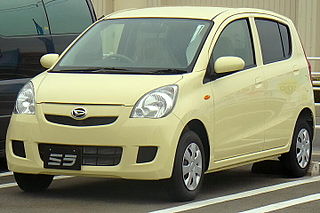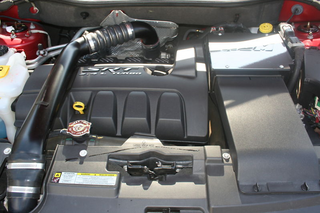The Mazda B-series is a small-sized, iron-block, inline four-cylinder engine with belt-driven SOHC and DOHC valvetrain ranging in displacement from 1.1 to 1.8 litres. It was used in a wide variety of applications, from front-wheel drive economy vehicles to the turbocharged full-time 4WD 323 GTX and rear-wheel drive Miata.

The Daihatsu Mira is a kei car and city car built by Japanese car maker Daihatsu. It has a variety of options and chassis variations, with the latest variant having four models: Mira, Mira AVY, Mira Gino, and Mira VAN. The Mira is the latest successor to the line of cars begun with the Daihatsu Fellow of 1966, and was originally introduced as the commercial version of the Cuore. Outside of Japan, the Mira has also been offered with larger 850 or 1000-cc engines. In Australia, the two-seater version was marketed as the Daihatsu Handivan and later as the Daihatsu Handi. The term mira is Latin meaning "goal" or "purpose".

The Mitsubishi Sirius or 4G6/4D6 engine is the name of one of Mitsubishi Motors' four series of inline-four automobile engines, along with Astron, Orion, and Saturn.

The Saab B engine is an inline four-cylinder car petrol engine developed by Saab Automobile. A redesign of the Triumph slant-four engine, the B engine displaced 2.0 L and first appeared in 1972. The B engine was used in the Saab 99 and 900 models. Saab began to phase the engine out in 1981.

The GM Family I is a straight-four piston engine that was developed by Opel, a former subsidiary of General Motors and now a subsidiary of PSA Group, to replace the Vauxhall OHV, Opel OHV and the smaller capacity Opel CIH engines for use on small to mid-range cars from Opel/Vauxhall. The engine first appeared in the Opel Kadett D in 1979, and shortly afterwards in its Vauxhall badged sister – the Vauxhall Astra Mk.1 in 1980. Despite this, the previous Opel OHV engine continued to be sold in entry level versions of the Opel Kadett/Astra and Corsa throughout the 1980s.

The Toyota KR engine family is a straight-3 piston engine, designed by Daihatsu, a subsidiary of Toyota. The 1KR series uses aluminium engine blocks and chain driven DOHC cylinder heads. It uses multi-point fuel injection, and has 4 valves per cylinder. Some versions have VVT-i variable valve timing. The engine is exceptionally light: 69 kg (152 lb) with all ancillaries.
The Toyota B engine family was a series of inline-four diesel engines.

The Toyota SZ engine family is a series of straight-4 piston engines with a forward-facing exhaust. Toyota Motor Manufacturing (UK) in Deeside produces SZ engines for the Yaris. All three types of the SZ engine are built in Tianjin FAW Toyota Engine Co., Ltd. (TFTE) Plant No. 1 in Xiqing District, Tianjin, China. The 2SZ-FE and 3SZ-FE variations are also manufactured by PT Astra Daihatsu Motor's Karawang Engine Plant in Indonesia.

The EN series engine is a four-cylinder, four-stroke engine used in kei cars sold by Subaru in Japan, succeeding the EK family of two-cylinder engines previously used in Subaru kei cars from 1958 to 1989. The EN family was introduced in 1989 and discontinued in 2012.

The Honda P engine is an inline three-cylinder gasoline engine first designed for use in Honda kei cars. The P engine was first used in the fourth generation Honda Life, as a successor to the Honda E07A engine. The P engine series was initially produced in only one displacement variant: 658 cc, either naturally aspirated or turbocharged. A turbocharged one-litre version, the P10A, has since been developed. The smaller version was discontinued in December 2013, when it was replaced by the new S07 series engine, but the P10A continues to be built in Thailand.

The Toyota NR engine family is a series of small inline-four piston engines designed and manufactured by Toyota, with capacities between 1.2 and 1.5 litres.

The Daihatsu E-series engine is a range of compact three-cylinder, internal combustion piston engines, designed by Daihatsu, which is a subsidiary of Toyota. The petrol-driven series has cast iron engine blocks and aluminum cylinder heads, and are of either SOHC or DOHC design, with belt driven heads.
The Daihatsu C-series engine is a range of compact three-cylinder, internal combustion piston engines, designed by Daihatsu, which is a subsidiary of Toyota. The engines range from 843 to 993 cc and have been manufactured in petrol and diesel-driven series. They have cast iron engine blocks and aluminum cylinder heads, and are of either SOHC or DOHC design, with belt driven heads. The engine first appeared in the all-new Daihatsu Charade in October 1977, in "CB20" form.

The World Gasoline Engine is a family of straight-4 piston engines, based on the Global Engine Alliance design.

The Daihatsu J-series engine is a series of the inline-four engines specially for Daihatsu's kei cars that was produced from August 1994 to August 2012. This was the only inline-four engine for Daihatsu's kei cars, debuted in the L502 Daihatsu Mira that was launched in September 1994.











